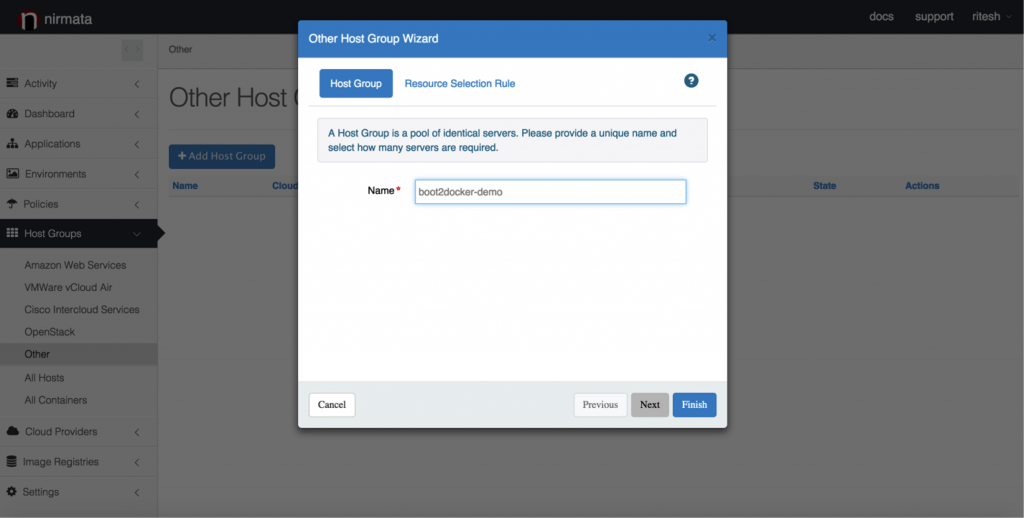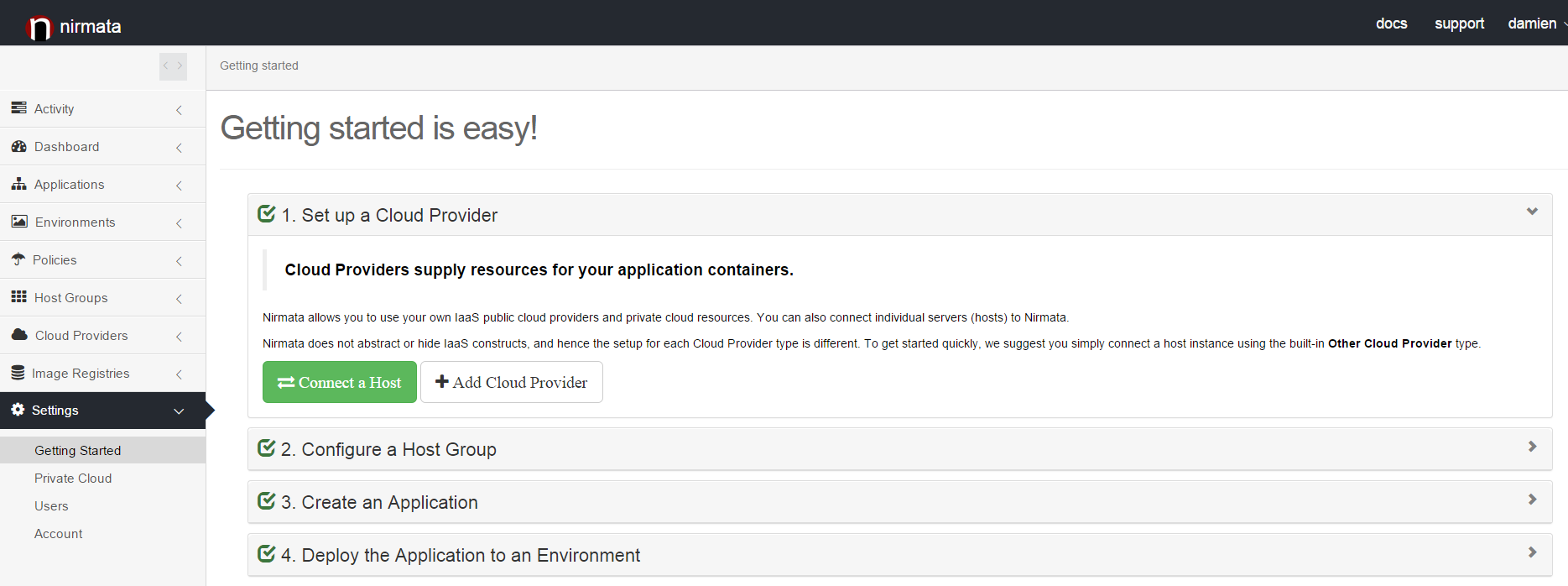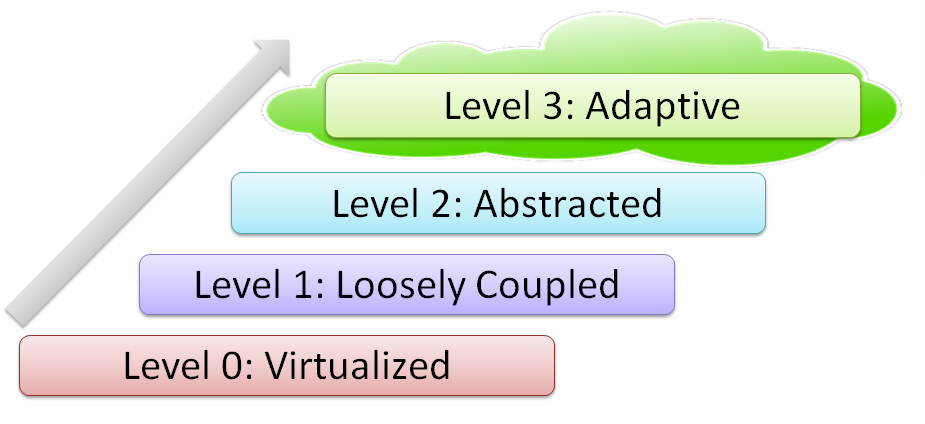If you are using boot2docker on MacOS, it is now easier than ever to deploy containerized applications on your laptop using Nirmata. You can be up and running in less than five minutes. In this post, I will describe the steps.
Deploy containerized applications on your laptop using Nirmata in less than five minutes
[fa icon="calendar'] Aug 9, 2015 4:16:51 PM / by Ritesh Patel posted in boot2docker, Containers, Nirmata, Cloud native, microservices, Engineering, DevOps, Docker
Deploy containerized applications on your laptop using Nirmata in less than five minutes
[fa icon="calendar'] Aug 9, 2015 4:16:51 PM / by Ritesh Patel posted in Engineering
If you are using boot2docker on MacOS, it is now easier than ever to deploy containerized applications on your laptop using Nirmata. You can be up and running in less than five minutes. In this post, I will describe the steps.
Tips on using Docker 1.7 with Nirmata
[fa icon="calendar'] Jul 6, 2015 3:15:00 PM / by Ritesh Patel posted in Engineering
Recently docker 1.7 was released and some of our customers are starting to use this with Nirmata. Docker 1.7 was a huge release with several new features & capabilities. Full release notes can be found at: https://github.com/docker/docker/blob/master/CHANGELOG.md
Tips on using Docker 1.7 with Nirmata
[fa icon="calendar'] Jul 6, 2015 3:15:00 PM / by Ritesh Patel posted in Engineering
Recently docker 1.7 was released and some of our customers are starting to use this with Nirmata. Docker 1.7 was a huge release with several new features & capabilities. Full release notes can be found at: https://github.com/docker/docker/blob/master/CHANGELOG.md
Managing MongoDB Clusters with Docker and Nirmata
[fa icon="calendar'] Jun 26, 2015 10:39:19 AM / by Damien Toledo posted in Containers, Product, microservices, Engineering, cloud, MongoDB, Docker
This is the second post in my series on managing clustered services with Nirmata. My previous post showed how to manage Zookeeper clusters. In this post, I will cover managing MongoDB clusters with Nirmata. You can skip this introduction if you have already read the previous post.
Managing MongoDB Clusters with Docker and Nirmata
[fa icon="calendar'] Jun 26, 2015 10:39:19 AM / by Damien Toledo posted in Product, Engineering
This is the second post in my series on managing clustered services with Nirmata. My previous post showed how to manage Zookeeper clusters. In this post, I will cover managing MongoDB clusters with Nirmata. You can skip this introduction if you have already read the previous post.
Managing Zookeeper Clusters with Docker and Nirmata
[fa icon="calendar'] Jun 1, 2015 6:29:09 PM / by Damien Toledo posted in Containers, zookeeper, Product, microservices, Engineering, cloud, Docker
A cloud native application may use several backing services, for things like messaging and data management. Typically these backing services are deployed separately from the application services, so multiple application instances (environments) can utilize them. Also, these backing services typically run as a cluster. In this blog post, I will show you how you can use Docker and Nirmata to easily deploy and operate a production Zookeeper cluster.
Managing Zookeeper Clusters with Docker and Nirmata
[fa icon="calendar'] Jun 1, 2015 6:29:09 PM / by Damien Toledo posted in Product, Engineering
A cloud native application may use several backing services, for things like messaging and data management. Typically these backing services are deployed separately from the application services, so multiple application instances (environments) can utilize them. Also, these backing services typically run as a cluster. In this blog post, I will show you how you can use Docker and Nirmata to easily deploy and operate a production Zookeeper cluster.
Cloud Native Application Maturity Model
[fa icon="calendar'] Mar 8, 2015 6:39:10 PM / by Jim Bugwadia posted in Engineering
Cloud native applications are built to run optimally on cloud infrastructure. Cloud native application architectures are very different than traditional tiered applications which are designed for a data center. In this post I will discuss maturity model, from the Open Data Center Alliance (ODCA), for assessing the cloud nativeness of an application.
Cloud Native Application Maturity Model
[fa icon="calendar'] Mar 8, 2015 6:39:10 PM / by Jim Bugwadia posted in Cloud native, microservices, Engineering
Cloud native applications are built to run optimally on cloud infrastructure. Cloud native application architectures are very different than traditional tiered applications which are designed for a data center. In this post I will discuss maturity model, from the Open Data Center Alliance (ODCA), for assessing the cloud nativeness of an application.




